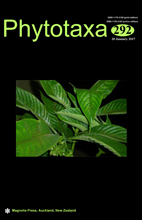Abstract
Two new rust species, Chrysomyxa diebuensis and C. zhuoniensis, on Picea asperata are recognized by morphological characters and DNA sequence data. A detailed description, illustrations, and discussion concerning morphologically similar and phylogenetically closely related species are provided for each species. From light and scanning electron microscopy observations C. diebuensis is characterized by the nailhead to peltate aeciospores, with separated stilt-like base. C. zhuoniensis differs from other known Chrysomyxa species in the annulate aeciospores with distinct longitudinal smooth cap at ends of spores, as well as with a broken, fissured edge. Analysis based on internal transcribed spacer region (ITS) partial gene sequences reveals that the two species cluster as a highly supported group in the phylogenetic trees. Correlations between the morphological and phylogenetic features are discussed. Illustrations and a detailed description are also provided for the aecia of C. succinea in China for the first time.

